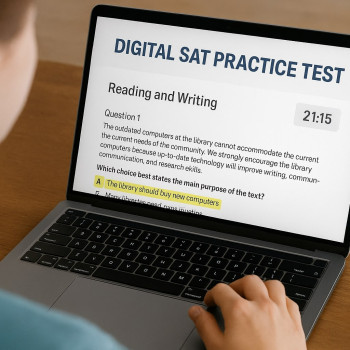How to Juggle SAT Prep With AP and IB Coursework
Some mornings you wake up convinced you can conquer algebra, a history essay, and a science lab—all before lunch. By dinner, you’re staring at your planner wondering how the heck you’ll fit SAT practice into a week already packed with APs or IB internal assessments. If that sounds familiar, take a breath. You’re not alone, and yes: it’s possible to prepare for the Digital SAT while staying on top of demanding AP/IB coursework—without burning out.
Why this balancing act matters (and why it’s doable)
AP and IB classes are intense by design: they dig deeper, expect more analysis, and train you for college-level thinking. Ironically, those exact skills overlap nicely with what the Digital SAT measures—critical reading, structured reasoning, problem solving, and clear written expression. The trick is not to treat SAT prep as an extra subject but as a companion to the work you’re already doing.
Think of your workload as a Venn diagram. In the middle: skills that help on both AP/IB exams and the SAT. If you build a strategy that prioritizes shared skills, you get two benefits for the price of one study session.
Map your priorities: Where to focus first
Start by answering two simple questions: What deadlines are fixed? And where are your gaps?
Fixed dates and sequencing
- AP and IB exam dates are typically immovable—those test windows are your backbone. Identify your busiest weeks (simulated exams, deadlines, internal assessments) and mark them off as lighter SAT weeks.
- SAT test dates repeat across the year. Pick 1–2 target dates: one earlier as a practice run and one later as your main attempt. Use the earlier sitting to diagnose weak areas, the later to improve.
Assess your gaps with surgical precision
Before you create a schedule, do a one-time diagnostic: take a timed Digital SAT section or a full practice test under exam conditions. Don’t obsess about your score; focus on patterns. Do you lose points on data-heavy reading passages? Do algebraic manipulations slow you down? Do you get tripped by time on multi-step math problems? The clearer your diagnosis, the smarter your study plan.
Weekly rhythms: realistic routines that actually stick
When your week is already dense with AP/IB obligations, micro-habits beat marathon sessions. Here’s a rhythm that many high-achieving students find sustainable:
Sample weekly template
- Daily mini-session (20–30 minutes): targeted SAT practice focused on one skill—vocab-in-context, data interpretation, or algebra review.
- Twice-weekly focused block (60–90 minutes): practice a whole section (Reading & Writing or Math) or work through AP/IB-aligned practice that doubles as SAT prep (e.g., close reading for English Lit).
- One weekly reflection (30 minutes): review mistakes, update your error log, and adjust the next week’s focus.
- Monthly mock test: full practice test under realistic timing to track progress (replace with a lighter full-section test during AP/IB heavy months).
Consistency matters more than volume. Twenty minutes every day will beat a single five-hour cram session when it comes to retention and stress management.
Make AP/IB content work for the SAT (and vice versa)
This is where the magic happens: stop treating the SAT as a separate chore and start leveraging your AP/IB work.
Cross-training ideas
- AP/IB essays = SAT writing prep: Use your extended-response practice to sharpen thesis clarity, evidence selection, and concise expression—skills that directly help with SAT writing questions and timing for written responses on other exams.
- IB internal assessments = data practice: IB science or math investigations often require interpreting charts and experimental results—great training for the Digital SAT’s data interpretation demands.
- AP Calculus/Statistics = SAT Math advantage: Brush up on methodical problem decomposition from AP classes to speed through multi-step SAT math problems.
- Close reading in AP Lang/Lit = Reading stamina and inference skills: Use annotated AP texts to practice paraphrasing paragraphs and identifying author intent—handy for SAT reading passages that reward quick synthesis.
When possible, let one study session serve two goals: annotate an AP reading while timing yourself on inference questions, or solve math homework by first predicting common SAT twist questions. This saves time and creates deeper learning connections.
Time-saving study techniques
Some study hacks are trendy; some actually work. Here are the ones that will save you time and improve results.
Active review, not passive repetition
- Error logs: After every practice session, log each missed question and write a 1–2 sentence reason why you missed it (careless error, concept gap, timing pressure). Review the log weekly.
- Explain aloud: Teach the problem to an imaginary class or a friend. If you can explain it, you understand it.
- Practice with purpose: Each practice block should have a single objective (e.g., “get faster at data interpretation” or “practice inference in 9-minute chunks”).
Use active materials—quality over quantity
Official practice materials that mirror the Digital SAT format are worth their weight in gold. Also, your AP/IB resources—past papers, mark schemes, and feedback from teachers—are precious because they reflect the level of analysis you’ll need on both test types.
Build a flexible study calendar (with an example)
Structure beats spontaneity, but rigidity kills motivation. Create a calendar that’s structured but adjustable for AP/IB peaks. Here’s a compact example showing how one month might look for a junior taking several APs and planning an October SAT.
| Week | AP/IB Focus | SAT Focus | Practice Time |
|---|---|---|---|
| Week 1 | Unit tests (AP Bio & AP Lang) | Diagnostic & error log setup | Daily 20–30 min; 2 × 60 min sections |
| Week 2 | Lab write-ups (IB internal assessment) | Data interpretation & science passages | Daily 20–30 min; 1 × 90 min focused block |
| Week 3 | Essay drafts & teacher feedback | Writing strategy, grammar rules | Daily 20–30 min; 2 × 60 min sections |
| Week 4 | Practice IB exams / AP practice | Full timed Digital SAT practice test | Mock test + review; light daily drills |
This calendar shows alternating emphasis so that SAT work never completely disappears during a heavy AP/IB week, while still respecting fixed academic obligations.
Smart practice: quality tools and routines
Choosing the right resources and routines reduces wasted effort.
What to include in each study session
- Warm-up (5–10 minutes): quick mental math or a couple of reading questions to shift into test mode.
- Core practice (15–50 minutes): focused practice on a single skill or section.
- Review (10–20 minutes): review mistakes and update your error log.
- Stretch/wind-down (5 minutes): jot down one thing you improved and one thing to focus on next time.
Resources that pair well with AP/IB study
- Official Digital SAT practice materials—the best reflection of test format and question style.
- Your AP/IB past papers and teacher feedback—use them for deep reading and complex problem practice.
- Timed question sets built around specific skills (data graphs, sentence structure, algebraic reasoning).

Handling high-pressure weeks (midterms, deadlines, final assessments)
In certain weeks you’ll be in triage mode. The goal then is maintenance: keep your SAT momentum alive without adding stress.
Maintenance mode checklist
- Reduce SAT practice to 3–4 short micro-sessions (10–15 minutes) focused on confidence (e.g., reviewing previously mastered topics).
- Skip full mocks and heavy new content—this isn’t the week to learn new concepts.
- Lean on passive study: listen to a recorded lecture, read a short passage aloud, or quickly review flashcards while commuting.
- Prioritize sleep, hydration, and a quick walk. Cognitive recovery is study time in disguise.
Why targeted help accelerates progress (and how to use it)
High-quality one-on-one guidance can turn months of frustrating practice into weeks of focused improvement. If you have access to personalized tutoring—say, Sparkl’s personalized tutoring—use it to:
- Identify the 10–20% of skills that cause 80% of your missed SAT points.
- Create a tailored study plan that fits around AP/IB deadlines and homework rhythms.
- Get immediate feedback on problem-solving tactics and writing clarity.
Good tutors don’t just teach content; they help you build efficient study habits, simulate test conditions, and keep motivation steady through busy academic periods.
Test-day strategies when you’ve been juggling a lot
When your SAT date arrives in the middle of AP/IB commitments, the best thing you can bring to the test is calm confidence and a clear plan.
Pre-test checklist
- Two nights before: taper study—no heavy cramming. Review high-yield notes and sleep early.
- Morning of: light breakfast, quick warm-up questions, hydrate. Avoid heavy social media scrolling that spikes anxiety.
- Strategy reminders: if you tried timing hacks in practice, use them; if you found one approach for hard math problems that works, trust it.
During the test
- Read actively—annotate, underline, and paraphrase short passages to maintain focus.
- Use the digital tools: the Digital SAT interface offers conveniences—practice with the same tools so they feel natural on test day.
- Manage pacing by section: set mini-checkpoints (how many questions you should be through after X minutes).
Real students, real schedules: mini case studies
Concrete examples help make plans feel practical. Here are two short, realistic profiles and how they blended SAT prep with AP/IB life.
Case study A: Maya — AP-loaded junior aiming for early action
Maya takes AP Bio, AP Chem, AP Lang, and one IB elective. Her school workload spikes with labs on Thursdays and essays due on Sundays. Maya’s strategy: short daily SAT drills (20 minutes) after dinner, two long practice blocks on Monday and Saturday (when labs are lighter), and one mock test every three weeks. She uses her AP lab data to practice SAT-style graphs and times essay outlines by practicing concise thesis statements she learned in AP Lang. Her tutor from Sparkl helped her convert lab report skills into SAT data-interpretation techniques—saving her time and lifting her confidence.
Case study B: Ethan — IB Diploma student with Internal Assessments
Ethan’s IB coursework involves frequent internal assessments and an extended essay. He blocks out 2–3 weeks before each big IA deadline for concentrated IB work and switches to a maintenance SAT schedule (micro-sessions and review) during those windows. In the months without big IB deadlines, he increases SAT intensity—two full sections per week and a monthly mock. Ethan uses past IB text analyses for SAT reading practice and times himself on extracted passages to simulate the Digital SAT environment.
Measuring progress sensibly
Progress isn’t only a number on a practice test. Use multiple signals to measure growth:
- Score trends on full practice tests (aim for steady upward movement or stabilization at higher accuracy).
- Reduction in repeat errors in your error log.
- Faster time-to-answer on practice question sets without a drop in accuracy.
- Improved confidence and reduced test anxiety—qualitative, but crucial.
Common pitfalls and how to avoid them
- Pitfall: Treating SAT prep as an add-on. Fix: integrate SAT practice into AP/IB routines so sessions pull double duty.
- Pitfall: Overcommitting to full mocks during heavy coursework weeks. Fix: switch to maintenance micro-sessions to conserve energy and prevent burnout.
- Pitfall: Ignoring official practice format. Fix: regularly practice with Digital SAT-style materials to avoid unpleasant surprises on test day.

Final pep talk: You are building transferable skills
Balancing SAT prep with AP/IB coursework is less about squeezing in more hours and more about becoming strategic. The skills you sharpen for APs and IB—the ability to analyze complex texts, reason through messy problems, and write with clarity—are exactly what makes the Digital SAT feel manageable. Think of each practice session as a two-for-one investment in both college credit and college-ready testing.
If you ever feel overwhelmed, remember that targeted help exists for exactly those moments. Short, focused tutoring—whether through a service like Sparkl or a trusted teacher—can reorient your study plan, give you techniques tailored to your profile, and free up your mental bandwidth to tackle both AP/IB and SAT goals with confidence.
Takeaway checklist: your next seven days
- Day 1: Do a timed diagnostic section and start an error log.
- Day 2: Build a flexible four-week calendar aligned with AP/IB deadlines.
- Day 3: Schedule daily 20–30 minute SAT micro-sessions for the next week.
- Day 4: Use an AP/IB assignment for cross-training (e.g., annotate a dense passage for SAT reading practice).
- Day 5: Do a focused 60–90 minute section and review mistakes.
- Day 6: Meet with a tutor or teacher for 30 minutes to target the top 2 weaknesses.
- Day 7: Rest, reflect, update the error log, and plan the next week.
Balancing SAT prep with AP and IB coursework is a marathon of smart choices, not a sprint of all-night study marathons. Be kind to yourself, lean on targeted help when you need it, and remember: every small, intentional practice session compounds into meaningful progress. You’ve got this.
Parting note
When you align SAT practice with what you’re already learning in APs and IB, you’re not adding work—you’re amplifying value. Let your classes inform your SAT strategy, let practice inform your class performance, and let smart support—like personalized tutoring—tighten the whole loop. Small, steady changes win the long race. Go make those changes tomorrow, and then celebrate the progress the weekend after.
















No Comments
Leave a comment Cancel